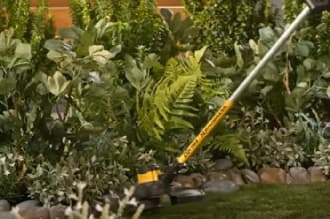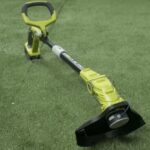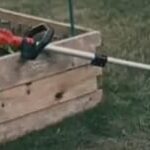As an Amazon Associate, this site earns commissions from qualifying purchases. For more information click here.
Many weed eaters have an automated feeding mechanism so you can focus on work. Sometimes though the feed line will not function. This can be frustrating, but there are ways to fix this. Before you attempt this, wear protective clothing and be careful when handling gas or electric weed eaters. Take all safety measures.
The wrong string size, a clogged trimmer head and spool not wound are the most common reasons a trimmer line gets stuck. Regular cleaning and using the right trimmer line size will fix the problem.
Dirty Trimmer Head
The trimmer head is exposed to a lot debris, and this has a direct effect on performance. You can remove the dust, grass and other debris to restore its functionality. Regular cleaning will prevent dirt and dust from clogging the trimmer head
Some cleaning tips:
- Wipe the weed eater with a clean cloth after every use. Pay close attention to the head.
- Every month or so, clean the trimmer head with a wet rag and stiff brush. Remove the debris, grass clippings etc.
- Aside from the trimmer head, clean the rest of the trimmer including the engine. Pay close attention to the nooks and crannies as that is where a lot of debris clog the system.
- There is no such thing as cleaning the trimmer head too often. Regular maintenance is going to prolong its life and make it work better.
Wrong Trimmer Line Size
String trimmers use monofilament lines for cutting. As the line rotates at high speed, it becomes stiff and capable of cutting through weeds, grass and other materials.
Use only the line size designed for your weed eater. The thicker the line, the more powerful the cutting capacity. But thick lines also require more power. If the line diameter is too large, the engine could wear out.
Most weed eaters use a 0.065-0.085 thick line. This is enough for standard grass and weed trimming. For thicker weeds you can go with 0.085-0.110 inches. If this is what you need, the Husqvarna 0.95 inch line is going to suit you.
If you have to cut thicker brush, get a line thicker than 0.110 inches.
The thicker the line however, the more it takes its toll on the engine. If you always use thick strings this can wear out the trimmer quickly.
Most trimmers have a line thickness support limit. Check your owner’s manual for the thickest line the trimmer supports.
Keep in mind that just because a weed eater supports a thick line, it cannot always be used. Use regular size lines as often as possible to preserve the engine.
Spool is Not Wound
If the spool is not installed or wound correctly, you will have problems with the line feed. Spool designs vary so check your owner’s manual. If you have to reconfigure the spool, the manual should have information on it.
The line feed will malfunction if the line size is wrong. Using an incorrect line size is going to wear out the mechanism much faster too.
If the line size is correct, make sure the line is not entangled in the spool. The feeding mechanism won’t work if the line is all jumbled up inside.
Weed eaters depend on centrifugal force for the line feed. If the line wounding is wrong the mechanism will not work.
Turn the weed eater off and take the spool out. Open the cap. The spool has to be even and wound smoothly. If the line is wound in the wrong direction, the feeding mechanism will be affected. You have to rewound the spool and make sure the direction is correct. There should be no bulges either.
Refer to the spool guide section in your owner’s manual on how to wound it. String trimmers also have arrows or markers that point in right direction to make line wounding easier.
Line is Welded to Itself
Sometimes the line can get stuck or fused because of high temperature. If this happens the line will not be able to advance.
The only way to fix this is to cut the part that has melted together. Wound the remaining line and try using the trimmer again.
If the problem keeps repeating itself, it means the line is of low quality. Replace the line with something of higher quality. Look also for those with anti-welding properties to prevent this from happening again. The Anleolife 0.95 round trimmer lines are heavy duty and will last a long time, which is why we prefer it.
Worn Out Housing
If the trimmer housing is cracked or damaged in any way, the line feed system is compromised. The trimmer housing and head must be replaced.
Replace any worn out weed eater parts as soon as possible. Not doing so can cause long term damage and prevent the trimmer engine from producing the spark needed to start it up.
The trimmer housing serves as the container and protection for the head. Through heavy use the housing may be chipped. Small cracks seem negligible, but that small rip will grow and spread.
The bottom line is you should always replace worn out weed eater parts. If you don’t, it could affect the entire line feed and cost more dollars to repair. It is more practical to replace damaged parts right away.
The replacement trimmer head and housing must be an exact match for your weed eater. Check the parts specifications and make sure it is compatible with your weed eater’s make and model.

Incorrect Usage
Weed eaters are used to trim weeds, grass and dry vegetation. If you use the tool as a hedge trimmer or as an edger, this can cause problems with the line feed.
There are attachments that can turn a weed eater into an edger, bush cutter etc. But if you use a weed eater as an edger without an attachment, it can damage the line feed.
Even the most powerful string trimmer is not going to last if used incorrectly. There are two options: install an attachment or do not use the weed eater as an edger or anything it wasn’t designed for
If your trimmer was used incorrectly and the line no longer feeds, open the cap and rewound the spool. Chances are it got entangled. If that does not work, check the rest of the trimmer for signs of damage or wear.
Of all the possible causes of a weed eater line not feeding, this is the easiest to fix. Read the operating manual and use it only as directed. If you want to use the trimmer for other yard work, look for an attachment that will allow you to do this.
The Feed is Not Automatic
String trimmer feed lines can be divided into two categories: bump feed and automatic. An automatic line feed is self explanatory. The line feeds automatically as you work.
A bump feed on the other hand is manual. You have to bump the head to advance the string. Make certain you bump the head on grass and not on a hard surface. Bumping the head frequently is a good idea to keep the line going.
Another problem with not bumping often is the line could end up being too short. This forces the head to spin too fast, causing it to wear out.
In other words, bump the line as often as possible. But do it on grassy surfaces to avoid damage. Of course if it is an automatic feeder this is not going to be a problem.
What Trimmer Line Should I Use?
Check the operating manual for the right diameter. There are many types of weed eaters, but all of them have line size limits. Never go over the limit as it can damage the trimmer head and the engine. If the line is thicker than what the system supports, it will overload the engine.
Some weed eaters support multiple line types. There are non-circular cross section and serrated strings available. These are more powerful than the average nylon line and has greater cutting power. You can use these for heavy duty work, but do it too often and it can wear out the engine.
To keep it simple: if the line is too large for the weed eater, the feed mechanism will not work. So stick with the limits set by the manufacturer.

I love the outdoors and all the tools for maintaining gardens, yards and lawns. The only thing I am more passionate about is sharing what I know about garden and outdoor equipment.


